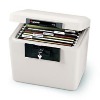SafeGuy
Member
Sorry to keep you waiting as I've been selling safes while you've been talking about them.So you're admitting that you have no actual knowledge, just what you have heard.
I claim that the cast insulations are better than gypsum board. I have and will post photos showing the failures of safes using gypsum board.
You claim that gypsum board is just as good as cast insulations. Therefore, you should be able to post photos of safes using cast insulations that have failed.
I'm waiting.
First, I never said that gypsum board is just as good as cast insulation. That's painting with too broad a brush. What I said is, the fire test of the BF Series AMSEC shows basically the same numbers as those on the Triumph Series Champion I showed as a comparable safe. Again, for whatever reason, you don't want to believe the test numbers and still maintain the BF series is better despite the fact the numbers on the Champion indicate otherwise. Need I remind you that AMSEC had two different fireboard-insulated safes with two different fire ratings, one of them being a UL 30 minute fire rating? They have a history of playing games with their fire ratings and actual safe weights.
Maybe it will better help you (and others) understand if we just look at AMSEC's test numbers on their cast insulated BF series vs their gypsum insulated series.
Here's a link to their SF Series gun safes using gypsum (though they don't call it that) where the test shows a 1,200 degree / 60 minute rating with three layers. Note the Mercury Class II rating (which is meaningless).
http://www.amsecusa.com/gun-safes-SF-main.htm
Here's a link to their BF Series using cast insulation where the test shows a 1,275 degree / 90 minute rating. Yep, you guessed it, that one has a Mercury Class III rating which is still meaningless.
http://www.amsecusa.com/gun-safes-BF-main.htm
AMSEC is following the lead of other gun safe manufacturers by offering a class 1, 2, 3, and 4 "rating" to enable a dealer to bump a customer up to a higher level of fire/theft security. Notice there is nothing to indicate ramp up times for their fire testing or any information whatsoever other than these so-called "Mercury" ratings which are in-house terms that are meaningless in the industry.
Here is a link to Champion's bit about their fire ratings and testing procedures. Substitute "Mercury" for "Phoenix", and you'll start to get the picture. At least they provided some of their test criteria.
http://www.championsafe.com/fire.html
Here's a link to Fort Knox which shows a very detailed chart regarding ramp up times along with inside temps after a specified exposure time. To their credit, there are no meaningless catch phrases used to describe their fire ratings. They let the numbers do the talking.
http://www.ftknox.com/redesign/advantages/fireprotection.htm
Bottom line is, both Champion and Fort Knox are backing up their numbers where AMSEC is not. Even if they were, it would still not prove that their BF series is superior to the equivalent (or higher rated) Champion or Fort Knox. To claim otherwise just doesn't make any sense. Would you claim that AMSEC's numbers for their SF Series are overstated?
Again, ANY safe can be destroyed by fire under the right circumstances. Rather than pick out a few photos of fireboard-insulated safes which burned up in a total loss situation, come up with some photos of the interiors of these different safes after they've been subjected to laboratory testing. That would better tell the tale.
There is no doubt anybody could come up with more photos of fireboard-insulated safes which have gone through fires as there are simply more of them in use. As for that Browning not surving an obvious totally involved house fire, you can bet no other comparably rated AMSEC (or other brand) would have survived either.
As for me having first hand knowledge (by your definition), there is never a reason for me to go and personally inspect a safe that's been through a fire. They are covered by the manufacturer's warranty, and locksmiths are called in to drill open the damaged safe as to allow its contents to be removed. After that, the safe is replaced either through the owner's insurance or the manufacturer's warranty.


